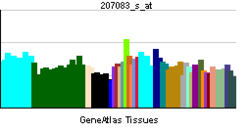CC2D1A
Coiled-coil and C2 domain-containing protein 1A is a protein that in humans is encoded by the CC2D1A gene.[1][2][3]
References
- ↑ Matsuda A, Suzuki Y, Honda G, Muramatsu S, Matsuzaki O, Nagano Y, Doi T, Shimotohno K, Harada T, Nishida E, Hayashi H, Sugano S (May 2003). "Large-scale identification and characterization of human genes that activate NF-kappaB and MAPK signaling pathways". Oncogene 22 (21): 3307–18. doi:10.1038/sj.onc.1206406. PMID 12761501.
- ↑ Basel-Vanagaite L, Attia R, Yahav M, Ferland RJ, Anteki L, Walsh CA, Olender T, Straussberg R, Magal N, Taub E, Drasinover V, Alkelai A, Bercovich D, Rechavi G, Simon AJ, Shohat M (Mar 2006). "The CC2D1A, a member of a new gene family with C2 domains, is involved in autosomal recessive non‐syndromic mental retardation". J Med Genet 43 (3): 203–10. doi:10.1136/jmg.2005.035709. PMC 2563235. PMID 16033914.
- ↑ "Entrez Gene: CC2D1A coiled-coil and C2 domain containing 1A".
Further reading
- Albert PR, Lemonde S (2005). "5-HT1A receptors, gene repression, and depression: guilt by association". The Neuroscientist : a review journal bringing neurobiology, neurology and psychiatry 10 (6): 575–93. doi:10.1177/1073858404267382. PMID 15534042.
- Strausberg RL; Feingold EA; Grouse LH et al. (2003). "Generation and initial analysis of more than 15,000 full-length human and mouse cDNA sequences". Proc. Natl. Acad. Sci. U.S.A. 99 (26): 16899–903. doi:10.1073/pnas.242603899. PMC 139241. PMID 12477932.
- Basel-Vanagaite L; Alkelai A; Straussberg R et al. (2003). "Mapping of a new locus for autosomal recessive non-syndromic mental retardation in the chromosomal region 19p13.12-p13.2: further genetic heterogeneity". J. Med. Genet. 40 (10): 729–32. doi:10.1136/jmg.40.10.729. PMC 1735276. PMID 14569116.
- Ota T; Suzuki Y; Nishikawa T et al. (2004). "Complete sequencing and characterization of 21,243 full-length human cDNAs". Nat. Genet. 36 (1): 40–5. doi:10.1038/ng1285. PMID 14702039.
- Lemonde S, Rogaeva A, Albert PR (2004). "Cell type-dependent recruitment of trichostatin A-sensitive repression of the human 5-HT1A receptor gene". J. Neurochem. 88 (4): 857–68. doi:10.1046/j.1471-4159.2003.02223.x. PMID 14756806.
- Gerhard DS; Wagner L; Feingold EA et al. (2004). "The Status, Quality, and Expansion of the NIH Full-Length cDNA Project: The Mammalian Gene Collection (MGC)". Genome Res. 14 (10B): 2121–7. doi:10.1101/gr.2596504. PMC 528928. PMID 15489334.
- Rush J; Moritz A; Lee KA et al. (2005). "Immunoaffinity profiling of tyrosine phosphorylation in cancer cells". Nat. Biotechnol. 23 (1): 94–101. doi:10.1038/nbt1046. PMID 15592455.
- Beausoleil SA; Villén J; Gerber SA et al. (2006). "A probability-based approach for high-throughput protein phosphorylation analysis and site localization". Nat. Biotechnol. 24 (10): 1285–92. doi:10.1038/nbt1240. PMID 16964243.
- Rogaeva A; Ou XM; Jafar-Nejad H et al. (2007). "Differential repression by freud-1/CC2D1A at a polymorphic site in the dopamine-D2 receptor gene". J. Biol. Chem. 282 (29): 20897–905. doi:10.1074/jbc.M610038200. PMID 17535813.
- Rogaeva A, Albert PR (2007). "The mental retardation gene CC2D1A/Freud-1 encodes a long isoform that binds conserved DNA elements to repress gene transcription". Eur. J. Neurosci. 26 (4): 965–74. doi:10.1111/j.1460-9568.2007.05727.x. PMID 17714190.


